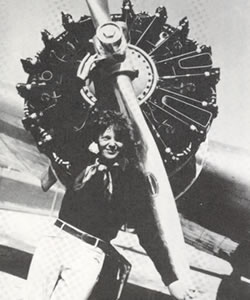Amelia Earhart ran out of fuel before she could find Howland Island.

The loss of Amelia Earhart has stirred-up controversy ever since her mysterious disappearance while crossing the Pacific in 1937. When Elgen Long made his record round-the-world flight in 1971, he duplicated Earhart's approach to Howland Island. The result inspired him to investigate the facts surrounding her last flight to discover the truth of what actually happened.
The "Crash and Sank" theory is simple: Amelia Earhart ran out of fuel before she could find tiny Howland Island and was forced to ditch her airplane in the ocean. Because her Lockheed Electra was a land plane, it filled with water and sank to the ocean bottom. It lies there in the deep abyss, undisturbed to this day.
Elgen had personal experience during World War II with the navigation techniques that Amelia Earhart and Noonan used at the time. He was appointed as an aircraft accident investigator by the Airline Pilots Association and has received training at the University of Southern California and Norton Air Force Base Crash Laboratory. The "Crash and Sank" theory is the culmination of a life's work and has been reviewed and confirmed by relevant experts in the fields of visual parameters, navigation, communications, and aircraft performance.
The disappearance of Amelia Earhart and her plane in 1937 was a tragic aircraft accident caused by multiple failures of navigation and communications. The accuracy of the procedures used by her navigator Fred Noonan were well known and documented. There was a ninety-percent probability that Noonan would not miss Howland Island by more than 62 miles.
All of Earhart's radio messages received between 7:42am and 8:43am by the Coast Guard cutter Itasca at Howland Island were logged as being received at signal strength 5. This is the strongest radio signal that exists on a scale of 1 to 5. At 7:42am Earhart reported she should be on them, and added "cannot see you but gas is running low." At 7:58am she reported she was circling and asked them to send homing signals so she could take a radio bearing. At 8:43am she said they were running north and south on the line of position 157-337. She asked them to wait and listen on the frequency 6210 kcs where she would repeat her message.
Her last transmission at 8:43am was nearly the same strength as the signal received from her at 7:42am. This confirms that Earhart was still in the immediate vicinity of Howland Island. No verified signal was ever heard from Earhart after 8:43am.
After 20 hours and 13 minutes, Earhart's flight came to an abrupt and tragic end. As the engines began to surge and sputter, Earhart would have to abandon any thoughts of radio messages. She must keep the Electra under control and prepare the plane for an emergency water landing. Looking at the sea below she must decide and turn to the direction that would offer the best chance of surviving the ditching. In a little more than ninety seconds, Amelia was nearing the point where she had to stop the plane's descent by bringing the plane's nose up before it contacted the surface of the ocean's swells. The Electra, a land plane, would soon fill with water and sink below the surface on its way to the bottom of the Pacific. To this day it rests quietly on the ocean floor, waiting to be discovered.
You can read more about Amelia's final moments and the Crash and Sank theory in the book Amelia Earhart: The Mystery Solved.